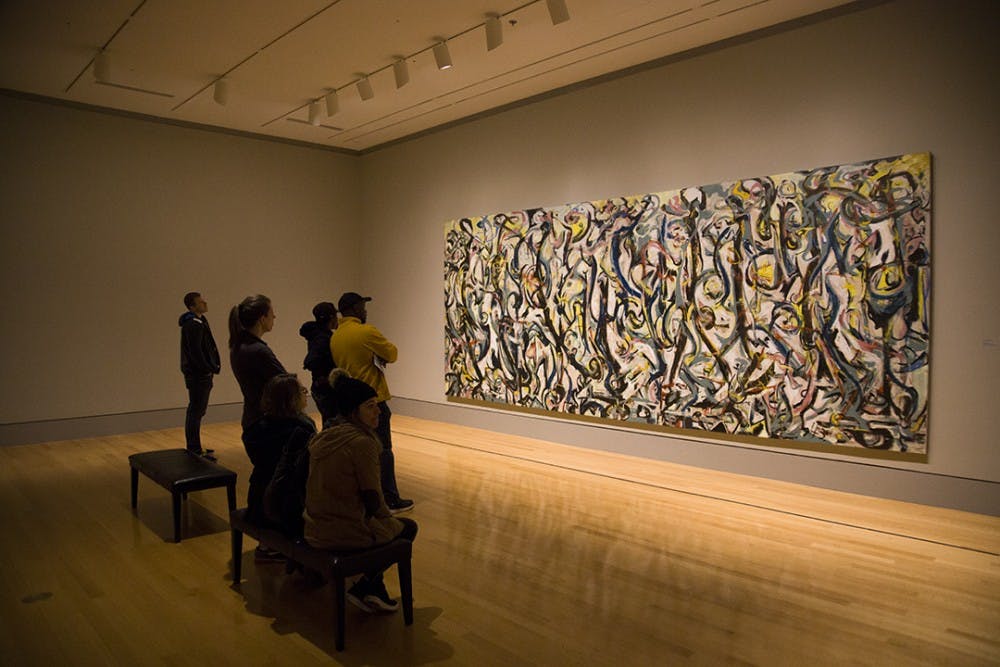The Columbia Museum of Art unveiled a new exhibit centered around Jackson Pollock’s seminal 1943 painting, “Mural" this December. The work, on loan from the University of Iowa Stanley Museum of Art, will remain on display in Columbia until the middle of May, when it will move to the next stop in an expansive tour.
The vast painting covers most of one wall, towering above the viewer. “Mural” is bold, with animated abstract forms and a dynamic array of colors. Curator Catherine Walworth describes the piece as “an opera of brushwork.” As with many abstract expressionist works, the painting doesn’t present the viewer with a concrete object or message, but rather with a collection of energized, engaging forms up for interpretation.
Even to the untrained eye, though, one thing about this painting stands out: While it is a Pollock, it doesn’t look like the paintings you’re probably imagining. The artist is enshrined in the popular imagination for his iconic, widely praised, and popularly lampooned abstract splatter painting technique; “Mural,” though, was created several years before he began using that characteristic, unconventional method that most of us remember him for today.
So, if this piece isn’t typical of that famous style we expect of Pollock, just what makes it so special?
While “Mural” is not the familiar Pollock of history books and art class PowerPoints, it is by no means an insignificant piece in art history. The painting represents an important turning point in Pollock’s career, both in terms of his artistic style and his renown, and its rich physical history serves as a way to take museum-goers behind the scenes to learn about the science of art conservation.
Walworth said the museum capitalized on the story of what the Getty did to “Mural."
"That's such an important moment in time," Walworth said. "Not only did they make the painting look more like its original self ... but they also helped break down this persistent myth that the painting had been painted in one night."
The exhibit follows the analytical techniques researchers and art historians used to demystify the painting’s origins, and follows the painting as it moves and endures modification and restoration. As the painting changed hands, it was varnished, rolled and unrolled, enduring all manner of modification, transportation, and aging.
With all this history to work with, the exhibit is more than artistically fulfilling, it’s educational, according to Milena Engh, a public relations specialist with the museum.
“This is a really great example of STEAM, so if you’re not an arts person, there’s an entire room of didactics about science, there's really is something for everybody to hold onto here,” Engh said.
The exhibit delves into the story of the painting’s life: “Mural” was created by a not-yet-famous Pollock, fresh from a stint working for Roosevelt’s Works Progress Administration in the early 1940s. Reluctantly, benefactor Peggy Guggenheim took a chance by commissioning a piece from the relatively unknown artist for her foyer.
Still something of a starving artist, the young Pollock had to discreetly dismantle one of the walls of his small apartment to accommodate the enormous canvas furnished by Guggenheim, sneaking buckets of drywall plaster out in the night, unbeknownst to neighbors and landlords. This and many other anecdotes bring the colorful, vital, physical history of the painting to the forefront with informative displays adorning the gallery spaces of the exhibit.
As for the painting itself? “I wanted it to glow off the wall,” said Walworth.
Standing before it, it’s easy to see how the grand piece jump started Pollock’s career.
“The grandiosity of this ... we’re not supposed to use this word, 'beautiful,' because it’s so subjective. I can’t help but find this beautiful.” said Walworth.

